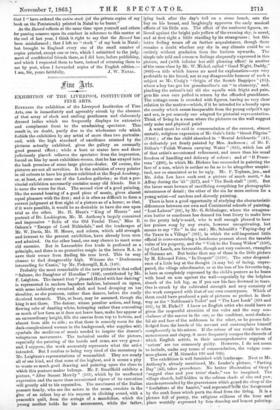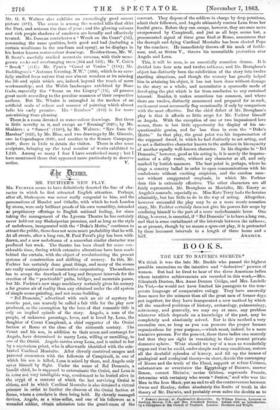Arts.
EXHIBITION OF THE LIVERPOOL INSTITUTION OF FINE ARTS.
ENTERING the exhibition of the Liverpool Institution of Fine Arts, one is immediately and agreeably struck by the absence of that array of sleek and smiling gentlemen and elaborately dressed ladies which too frequently displays its extensive and complacent front to the unadmiring spectator. This result is, no doubt, partly due to the wholesome rule which forbids the exhibition by any artist of more than two portraits: and, with the high standard of excellence attained by the pictures actually exhibited, gives the gallery an unusually good general effect ; while a bust or statue here and there judiciously placed. relieves the spectator from the impression, forced on him by most exhibition-rooms, that he has strayed into the back premises of some large picture-dealer. Of course, the pictures are not all novelties. It is the ambition of every painter in oil colours to have his picture exhibited at the Royal Academy, or, at least, at some one of the London galleries ; so that a pro- vincial exhibition necessarily contains many old friends. But it is none the worse for that. The second view of a good painting, like the second hearing of a good piece of music, gives almost equal pleasure with the first ; and it is often as difficult to form a correct judgment at first sight of a picture as of a horse; so that, if it were possible, it would be as desirable to have the one upon trial as the other. Mr. H. Hunt's "King of Hearts" and portrait of Dr. Lushington, Mr. M. Anthony's largely conceived and impressive " Relic of the Old Feudal Time," Miss E. Osborn's "Escape of Lord Nithisdale," and the landscapes of Mr. W. Davis, Mr. H. Moore, and others, which add strength and interest to the present exhibition, have already been seen and admired. On the other hand, one may chance to meet some old enemies. But in Lancashire free trade is professed as a principle, and there is no protective magic in the letters R.A. to save their owner from finding his true level. This lie may chance to find disagreeably high. Witness the " Desdemona interceding for Cassie," by Mr. Pickersgill, R.A. (149).
Probably the most remarkable of the new pictures is that called " Salome, the Daughter of Herodias " (160), contributed by Mr. F. Leighton. The damsel that " pleased Herod with her dancing" is represented in modern bayadere fashion, balanced on tiptoe, with arms indolently wreathed aloft and head drooping on her shoulder, as she postures, rather than dances, before the easily deceived tetrarch. This, at least, may be assumed, though the king is not there. The dancer, whose peculiar action, and long, flowing robe of dazzling white, betraying rather than concealing so much of her form as it does not leave bare, make her appear of an extraordinary height, fills the canvas from top to bottom, and almost from side to side ; so that there is scarcely room for the dark-complexioned woman in the background, who supplies with cymbals the modicum of music needed to inspire the dancer's voluptuous movements. The technical merits of the picture, especially the painting of the hands and arms, are very great : and, I suppose, the work accurately represents what the artist intended. But I confess to being very tired of the monotony in Mr. Leighton's representations of womankind. They are nearly all of one kind, and that none of the highest, and it seems a pity to waste so much good drawing and painting upon the class to which this posture-maker belongs. Mr. F. Smallfield exhibits a picture, "After Sunset Merrily" (105), which by its unaffected expression and the more than accustomed vigour of its execution will greatly add to his reputation. The merriment of the Italian peasant family, who are the actors in the scene, consists in the glee of an infant boy at his success in eliciting sound, with a peacock's quill, from the strings of a mandoline, which the young mother holds for his amusement, while the father, lying back after the day's toil on a stone bench, sets the boy on his breast, and laughingly approves the early musical efforts of his little son. The effect of the sunburnt figures, re- lieved against the bright pale yellow of the evening sky, is novel, and at first sight a little startling by its strangeness ; but this latter feeling wears off on further acquaintance, though there remains a doubt whether any sky in any climate could be so entirely without gradation from the horizon upwards. The simple tale told and common feelings eloquently expressed in this picture, and (with inferior but still pleasing effect) in another of the same class by Mr. W. Nichol, called " Good Night, Daddy," (989)—a title which leaves no need for explanation—are very preferable to the forced, not to say disagreeable humour of such a subject as Mr. Craig's " Origin of the Scotch Bagpipes " (15), where a boy has got his grandmother's eat " in chancery," and, pinching the animal's tail till she squalls with fright and pain, gets his own ears pulled in return by the offended granddame.
The cottage-room is crowded with figures, having no very clear relation to the matter—which, if it be intended for a homily upon the cruelty which seems inseparable from the young culprit's ago and sex, is yet scarcely one adapted for pictorial representation. Think of living in a room where the pictures on the wall suggest only noise and physical pain!
A word must be said in commendation of the earnest, almost ecstatic, religious expression of Mr. Gale's little "Greek Pilgrim" (1184) ; of the fair child absorbed in "Mental Arithmetic" (41), so delicately yet firmly painted by Mrs. Anderson ; of Mr. F. Dillon's "Fellah Women carrying Water " (335), which has all of that artist's accustomed refinement, and more than his usual freedom of handling and delicacy of colour ; and of " Il Pease- rosa " (290), in which Mr. Dicksee has succeeded in painting the face of a nun, which is neither so fat as to be altogether unspiri- tual, nor so emaciated as to be ugly. Mr. F. Tepham, jun., and Mr. John Lee have each sent a picture of much merit, " An Affray during the '45 " (227), and "The Book-stall" (459). But the latter must beware of sacrificing everything for photographic minuteness of detail ; the other of the sin far more serious for a young artist—of careless and slovenly painting.
There is here a good opportunity of studying the characteristic differences between our own and Continental schools of painting.
" Lost Labour" (66), by Mr. G. Schlesinger, where the sexagena- rian butler or coachman has donned his beet livery to make love to the pretty lady's-maid, who is well enough pleased to hear her praises sung by any swain, however uncaptivating, but means to say "No" in the end ; Mr. Schmidt's "Paying-day of the Taxes in a Village" (361), in which the self-important little official is cross-examining a handsome peasant about the taxable value of his property, and the " Visit to the Young Widow" (258), by Carl Leech, are favourable, though not very eminent, examples of German art. But better than any of these is the little picture by M. Edonard Frere, " In Despair" (1138). The utter despond- ence of a little boy at the thought (it may be) of facing, unpre- pared, the village schoolmaster, or at the loss of his favourite toy, is here as completely expressed by the child's posture as he leans with head on arm against the wall—especially by the helpless slouch of the left leg, as if you saw his face drowned in tears.
One is struck by the cultivated strength and easy certainty of the work compared with that of our own countrymen. Which of them could have produced a pair of pictures so perfect in their way as the " Nobleman's Toilet" and " The Last Look" (333 and 332), by M. Fichel ? I know no English artist who could have so
given the respectful attention of the valet and the easy non-
chalance of the master in the one, or the confident, semi-disdain- ful air and face of the nobleman in the other, as he passes full- fledged from the hands of his servant and contemplates himself complacently in his mirror. If the colour of our rivals be often monotonous and clayey, it more frequently escapes the discords of which English artists, in their uncomprehensive oopyism of nature" are too commonly guilty. However, I do not mean to include, under any terms of commendation, the vulgar com- mon-places of M. Girardot 138 and 33p).
The exhibition is well furnished with landscape. Next to Mr. Anthony's, already mentioned, Mr. Leader's picture, " Parting
Day" (43), takes precedence. No better illustration of Gray's "rugged elms and yew trees' shade," can be imagined. The village church, half-hidden in the solemn shade of elm and yew, stands surrounded by the gravestones which guard the sleep of the " forefathers of the hamlet," and separatedvir& the foreground by the sunk fence which parts the dead from the living. It is a picture full of poetry, the religious stillness of the hour and place worthily expressed by firm drawing and honest painting.
Mr. G. S. Walters also exhibits an exceedingly good sunset picture (381). Tho scene is among the wooded hills that skirt the Dart, and autumn the time of year ; and the glowing colours and rich purple shadows of sundown are broadly and effectively treated. Mr. Duncan contributes a "Wreck on the Coast" (55), possessing the same qualities, both good and bad (including a certain woolliness in the sea-foam and spray), as he displays in his better known water-colour drawings. Besides these, Mr. W. B. Scott's carefully studied mountain streams, with their moss- grown rocks and overhanging trees (364 and 733); Mr. V. Cole's " Brook" (271); Mr. Pyne's "Canal at Venice " (178); Mr. Boddington's "Autumn Evening, N.W." (200), which is so care- fully studied from nature that one almost wonders at its missing the life and spirit which are, indeed, beyond the reach of mere workmanship ; and the Welsh landscapes exhibited by Hans Gude, especially the "Scene on the Llugwy" (75), all possess great merit according to the peculiar manners of their respective authors. But Mr. Whaite is entangled in the meshes of an artificial scale of colour and manner of painting which almost belie his early promise. His " Rainbow" (131) is far more astonishing than pleasing.
There is a room devoted to water-colour drawings. But there is little novelty in it, and except an " Evening" (627), by Mr. Shilders ; a " Sunset" (1198), by Mr. Walters ; "Rye from the Marshes" (625), by Mr. Hine, and two drawings by Mr. Glennie, one in Copenhagen (639), and another in the Roman Campagna (640), there is little to detain the visitor. There is also some sculpture, bringing up the total number of works exhibited to 1,240. Among so many I fear I have overlooked many ; but I have mentioned those that appeared more particularly to deserve































 Previous page
Previous page